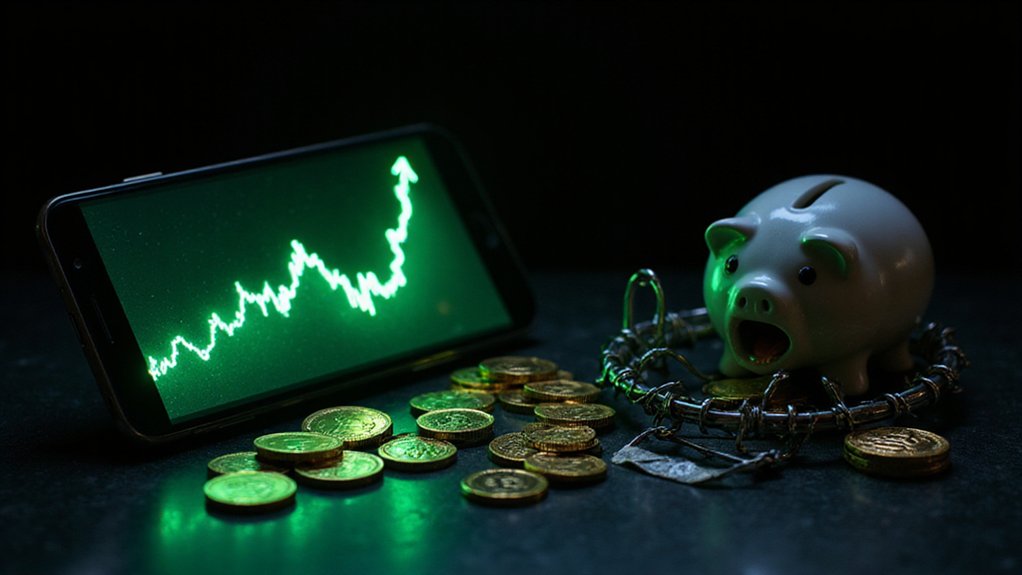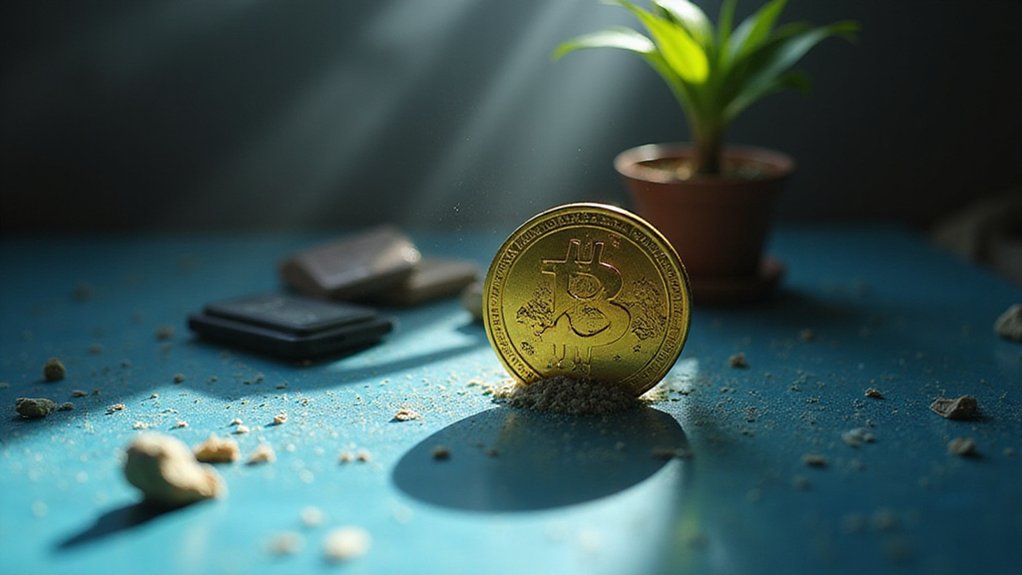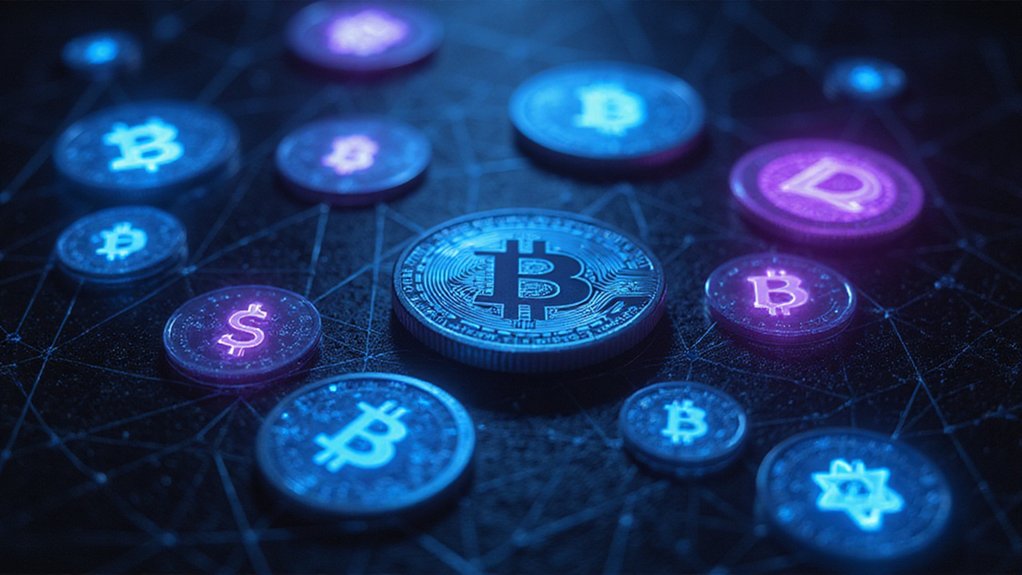Crypto pump and dump schemes exploit investor psychology through coordinated market manipulation. Orchestrators acquire substantial positions in low-market-cap cryptocurrencies before launching aggressive promotional campaigns across social media. As FOMO-driven investors pile in, prices temporarily soar, allowing schemers to quietly liquidate their holdings at inflated valuations—leaving latecomers holding effectively worthless assets. Regulatory authorities classify these operations as securities fraud, though enforcement remains challenging in decentralized environments. Understanding these mechanics constitutes your first line of defense against digital-age financial predation.

How easily can an unsuspecting investor be lured into the treacherous waters of cryptocurrency scams?
The answer, regrettably, lies in the psychological allure of swift wealth accumulation and the meticulously orchestrated deception known as the “pump and dump” scheme.
This financial sleight of hand typically commences with the selection of a vulnerable asset—usually a low-market-cap cryptocurrency with minimal trading volume, rendering it particularly susceptible to price manipulation.
The architects of these schemes acquire substantial positions in the chosen token before initiating a carefully choreographed promotional campaign.
Social media platforms become their theater of operations, where misinformation proliferates with viral efficiency.
Social media transforms into a manipulation stage where falsehoods spread with calculated precision and algorithmic reach.
Forums and chat groups—ostensibly offering “insider tips”—serve as echo chambers amplifying falsified projections and fabricated partnerships.
(One might reasonably question how investors consistently fall prey to such transparent machinations, yet FOMO remains a powerful motivator in financial markets.)
The execution unfolds in predictable phases: pre-launch hype generation, coordinated promotional bombardment at launch, the subsequent price inflation as unwitting investors rush to participate, followed by the inevitable “dump”—when orchestrators liquidate their holdings at peak valuations.
Regulatory authorities across jurisdictions have classified these deceptive practices as securities fraud and continue to investigate suspicious trading patterns despite challenges in enforcement.
Unlike pump-and-dump schemes, a true rug pull occurs when crypto project developers suddenly and completely withdraw all liquidity from the project, essentially abandoning it and leaving investors with worthless tokens.
The aftermath leaves legitimate investors holding virtually worthless digital assets, their investments evaporated into the ether¹.
ICO scams, rug pulls, and pre-launch hype campaigns represent variations on this fundamental theme, each exploiting similar vulnerabilities in investor psychology.
Particularly susceptible are cryptocurrency neophytes lacking the experiential framework to identify telltale warning signs, and risk-seeking individuals drawn to potentially astronomical returns.
Protective measures exist for the prudent: rigorous information verification, skepticism toward hyperbolic promotional activities, and thorough understanding of market dynamics.
Regulatory bodies increasingly scrutinize these activities, though enforcement remains challenging in decentralized environments.
The sophistication of these schemes notwithstanding, their effectiveness ultimately depends on an eternal truth of financial markets—the persistent belief that one has discovered an exceptional opportunity that others have overlooked.
Conducting thorough research on the project team’s background and their technology can significantly decrease your vulnerability to these malicious investment traps.
In cryptocurrency markets, as elsewhere, extraordinary claims warrant extraordinary scrutiny.
¹No pun intended, though the irony is difficult to ignore.
Frequently Asked Questions
Who Are the Major Regulators Monitoring Crypto Pump and Dump Schemes?
Major regulatory bodies monitoring crypto pump and dump schemes include the CFTC, which maintains anti-fraud authority over virtual currency markets in the U.S., and the SEC, increasingly involved in cryptocurrency oversight.
Internationally, the UK’s FCA and the global FATF play significant roles.
These agencies face considerable challenges—the decentralized, often anonymous nature of cryptocurrency transactions complicates enforcement efforts, while inconsistent international regulations create jurisdictional gaps that savvy manipulators exploit with remarkable efficiency.
What Technological Tools Can Detect Pump and Dump Patterns Early?
Several technological tools can detect pump and dump patterns early.
Algorithmic pattern recognition systems analyze historical data to identify suspicious trading activities in real-time.
Machine learning models flag anomalies by detecting unusual price and volume spikes inconsistent with market news.
Network analysis tools track wallet connections and transaction histories, revealing coordinated manipulation efforts.
Real-time monitoring platforms like CryptoPumpFinder alert users to abnormal market movements (e.g., 5% change in 10 minutes), while AI-powered systems continuously evolve to counter increasingly sophisticated schemes.
How Do Legitimate Price Rallies Differ From Pump and Dump Schemes?
Legitimate price rallies display organic momentum characterized by gradual appreciation, substantial trading volumes across diverse participants, and catalysts grounded in verifiable fundamentals.
Pump and dumps, conversely, manifest as suspiciously vertical price trajectories in low-cap assets, accompanied by coordinated social media hysteria and artificially inflated volumes—only to collapse precipitously once orchestrators exit their positions.
The former builds sustainable value; the latter leaves a trail of bewildered investors holding functionally worthless digital assets.
Are Certain Cryptocurrencies More Vulnerable to Manipulation Than Others?
Yes, certain cryptocurrencies exhibit heightened vulnerability to manipulation.
Small-cap tokens with limited liquidity present prime targets, as relatively modest capital can trigger significant price movements.
Unregulated exchanges, newly launched projects with unvetted teams, and tokens with questionable tokenomics similarly invite manipulation.
The social media darlings—particularly meme coins—often find themselves subject to influencer-driven price distortions that bear little relation to fundamentals.
Even established cryptocurrencies aren’t immune, though their larger market caps provide some structural resistance to brazen manipulation attempts.
What Penalties Do Organizers Face if Caught Running Pump Schemes?
Organizers of pump schemes face a veritable gauntlet of consequences if caught.
Securities fraud, wire fraud, and market manipulation charges can lead to decades of imprisonment—up to 20 years per count in severe cases.
Financial penalties often reach into the millions, with regulators like the SEC extracting both ill-gotten gains and punitive damages.
Additionally, perpetrators must contend with civil lawsuits from aggrieved investors and the permanent stain of reputational damage that follows such malfeasance.









